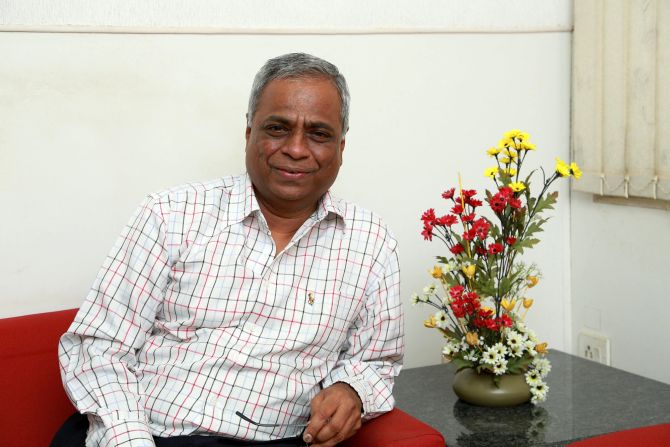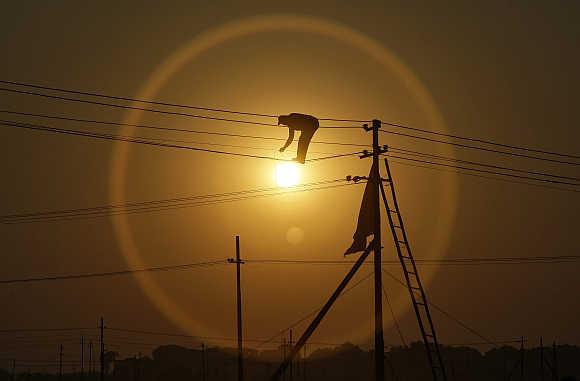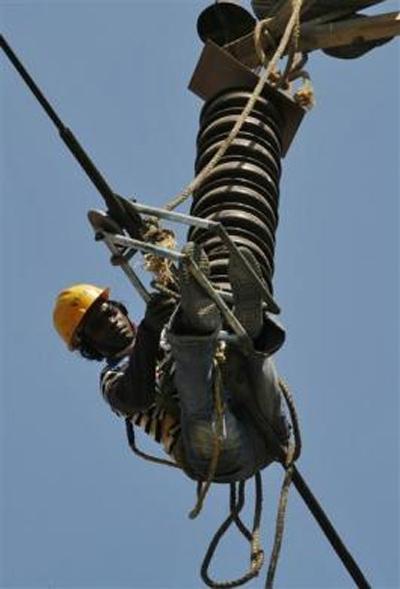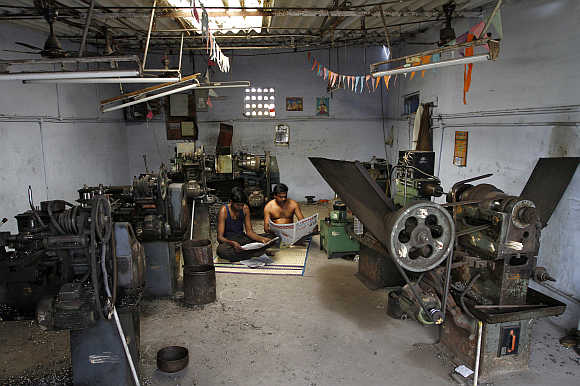
‘Expensive petrol-based generators are not the solution. We need alternative solutions. We need a situation where power cuts become a thing of the past.’
‘Instead of blackout, we call this brownout. Brownout means, say 10 percent of power is transmitted. Instead of 100 percent power cut you can have 90 percent power cut and meet the demand for a few critical devices in every home like fans, lights, TVs and cellphones.’
‘India is too huge and by making it work in India, we can show the world how we can move ahead. The future is the solar and DC combination.’
Professor Ashok Jhunjhunwala of IIT-Madras speaks of his revolutionary method of preventing power cuts, in an interview with Shobha Warrier/Rediff.com
If everything works as planned by Professor Ashok Jhunjhunwala of the Indian Institute of Technology-Madras, and Professor Bhaskar Ramamurthi, his colleague and the present director at IIT-Madras, there will not be any power cuts or blackouts in India within the next two-three years.
After the revolutionary Wireless in Local Loop technology (which Rediff.com first wrote about in 1997), low voltage DC power may be the next big thing that can happen in India.
Let's listen to what has been envisaged by Prof Jhunjhunwala to alleviate the power shortage and frequent power cuts India faces now.
You said the lights and fans in your room are powered by DC (direct current) power...
Let me start at a general level first. All over India, people suffer from huge power cuts because our supply during the peak hours, is much less than the demand. At least 30 percent of Indian homes are not connected. That is mainly because there is not enough power. Then, there are power cuts from two hours to 20 hours a day, more in the villages and also in every city!
It means people use inverters. When you use inverters, you are storing energy and thereby losing 30-35 percent while using it. When the power comes back, there will be a surge of power which may affect your appliances and also result in more power cuts.
If you use a petrol generator, the cost of electricity today for a consumer is between Rs 35 and Rs 89 per unit. If you use a diesel generator, it will cost you Rs 24-25 per unit if it is running at full power, and if it is running at half the power, it can go up to Rs 35. The cost of battery power is Rs 17-20.
Power shortage is one of the major problems India faces now. Industry shuts down. Manufacturing faces a crisis. So we wanted the gap between the demand and supply to be reduced to zero as early as possible. The question is, how do we do this? You can buy oil and generate enough power to bridge the gap but what about the cost? When the cost goes high, it become unaffordable. Expensive petrol-based generators are not the solution. We need alternative solutions. We need a situation where power cuts become a thing of the past.
...

What made you work on the issue of power shortage?
This has been haunting all of us for a long time but this is not our field. So, we thought somebody else would do it. Two years back, when Chennai was going through very bad power cuts, Bhaskar and I felt we should do something.
One of our colleagues who was working on solar power used to say, why not solar power? Along with solar power, we saw very interesting things happening in power electronics.
Integrated circuits can handle only low power. By 2004-05, power electronics ICs came in and suddenly there was brushless DC motors or BLDC motors as opposed to an AC (alternating current) induction motor. We found that small BLDC motors are twice as energy-efficient as compared to AC motors.
With Light-Emitting Diodes (LEDs), lighting became more efficient.
So, there was solar, DC motors and then, LED. That was when we thought of connecting all these and doing something in this area.
How did the idea to look at DC power come to your mind?
We realised that all the electronics we use are DC while we have AC lines. At every point, we convert AC power to DC. In LED tubes, in cellphones and laptop chargers, in LED or LCD TVs, in the BLDC fans, everywhere, we are converting AC to DC power.
When you convert AC to DC at every point, there is a cost to it and you also lose a lot of power.
Similarly, solar was producing DC power which we convert to AC and use. In batteries, we are converting AC to DC to store power, and then back to AC. That was when I thought, why don't we have DC power at least at homes and in offices?
From the substations, power is transmitted as AC...
Yes, let the power come from the sub-stations as AC. Let us convert it into DC at our premises.
Will there be more transmission loss if we transmit power as DC from the substations?
Yes. There will be transmission loss and also, changing AC to DC at the sub-station is a major issue. We didn't even want to get into that area. What we felt was, let the change take place at homes as 95 per cent of Indian villages have electricity lines connected. That is why we wanted the lines to homes and offices changed to DC power.
When the supply in the city is less than the demand, in certain pockets and sub-station areas, there is a blackout or power cut or load-shedding so that demand and supply matches. That is when we came up with this idea a year back with an innovative idea; why can't a small amount of power come when there is load-shedding?
Instead of blackout, we call this brownout. Brownout means, say 10 percent of power is transmitted. Instead of 100 percent power cut you can have 90 percent power cut and meet the demand.
...

How can you transmit a small amount of power?
Yes, the question is, how can you have 10 percent power with the local distribution system not collapsing? What we thought of was, at the meter-point at homes, we can have two lines, one of which will be the normal AC line that comes from the substation from which you draw whatever you want. Our plan is to cut off that AC line during the brownouts.
Does it get cut off automatically?
Yes, automatically, it will get cut off during the brownouts. The other line, a low voltage 48-volt DC line, will always be on, both during the normal times and power cuts. It is a 24x7 line but you can't draw whatever you want and you can use some appliances.
What are the appliances that you can use?
Only the essential ones which you don't want to fail, like fans, lights and other electronics items. You may use three lights, two fans and a mobile charger.
How will the cutoff from the AC line to the DC line happen?
The cutoff has to happen instantaneously within a millisecond when the brownout situation happens. If you don't do it, the network will collapse.
We thought quite a bit on this. We wondered, can we significantly drop down the voltage at the substation in the existing line? If a home is generally getting 230 volts, it will suddenly drop down during the brownout. It will be back to 230 volts during normal times. When the drop in voltage happens, the AC line is off and the next line is turned on. So, during the brownout, only the second line will be on.
Then we thought of making the second line, a low voltage DC line. We decided on a 48-volt DC line which is safe and all the DC electronics devices like fans, TV, laptops, cell phone chargers, LED lights, tablets, speakers can function.
If we add a solar panel to this, we do not have to make any conversion as solar power is DC.
Was this a Eureka moment for you?
Yes, I think so. For four months, Bhaskar and I were thinking and discussing this between us and with our colleagues. We had thought of the concept of two lines, one DC line, etc.
The Eureka moment was, how do you really get the brownout signalling done, and you continue to get low voltage from the existing grid. Suddenly one day, we came up with this simple idea of reducing the voltage to do the signalling. That was the key.
If a home has to have a DC line connected to the essential devices, what will be the cost of wiring the homes with a DC line?
It will cost between Rs 1000 and Rs 2000; it is just like the wiring you do for inverters, and India is used to inverter wiring. It depends on how many points you want to have.
The advantage is having a direct line from the solar panel which doesn't need any conversion. A solar panel costs around Rs 50,000.
Tomorrow, when all the electronic devices move completely to DC, you can add more points. Today, there are already energy efficient inverter-based refrigerators, ACs and washing machines coming to the market.
...

Is it because it is energy efficient that these electronic devices are moving to DC now?
Yes, they are energy efficient and all over the world, it is happening. And all these inverter-based electronic devices use DC power.
Other than having no power cuts, what are the advantages for a consumer to have a second DC line?
There are multiple advantages.
First, uninterrupted power.
Second, by introducing energy efficient devices, we reduce the demand for power. When we reduce the demand, the gap between supply and demand improves.
Three, we are adding a solar panel which most upper middle-class and middle-class homes can afford as a one-time investment of Rs 50,000. When 100 million homes buy a 1 kilowatt solar panel, you are generating 100 gigawatt. That way, we are enhancing the supply side too.
Four, power bills will come down by 40 percent as you are consuming less power. For your solar power, you are not going to pay your bill. So, effectively, you can reduce your bill to 20 percent. There will be an overall reduction of 70-75 percent in your electricity bill.
Where did you test this first?
We decided to do the testing at the homes and departments at IIT-Madras. For that, we tied up with partners like Crompton Greaves making DC fans for us. Similarly, we have tied up with others like Solarsis, Intelizon, etc in making lights, converter meters, chargers, etc for us. Then, we installed all these in the homes at IIT and then in our departments, and now, we are installing them at the IIT hostels.
We have also signed MoUs with the state electricity boards of all the four south Indian states and in each area, we will work in 500 homes. The first place where we have started testing is at 300 homes in Hyderabad and another 500 homes in Marundagam in Tamil Nadu. We are also tying up with new builders who are building hundreds of flats.
How revolutionary is this idea for a country that is reeling under an acute power shortage?
When we started talking about WLL in the early 1990s, the country had only five million phones. Today, where are we?
Power is even more important. We have only started with homes, and soon we will move to industries and agriculture.
Are you looking at the world market?
India is too huge and by making it work in India, we can show the world how we can move ahead. Our concentration is only India. The future is the solar and DC combination.
If we follow this properly, in two years we can have uninterrupted power in all homes throughout the country. We can't let the world move and then follow. For too long, we have only been following in technology. It has to end.